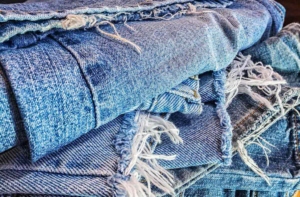5 Reasons to Consider a Textile Recycling Program for Your Organization
Americans sent more than 17 million tons of textiles to landfills in 2018, a volume that is only increasing every year, reports the Environmental Protection Agency. When you think about the fact that it can take over 200 years for textiles to decompose, it’s easy to grasp how large textile waste’s contribution is to the environmental crisis threatening the planet today. Everyone needs to be part of the solution to reverse these trends.
We can’t count on individual consumers or other organizations to take action to prevent textiles from heading to landfills. Retailers and multi-family housing organizations are in a promising position to be at the forefront of change.
Starting a textile recycling program in your multi-family housing units or retail stores doesn’t only help divert millions of pounds of clothing from the landfill, but it also benefits your business and community in real, tangible ways. Local efforts make a big difference. Here’s how.
Textile Recycling Benefits for Organizations
Whether you’re a retailer or multi-family organization, there are multiple benefits to having a textile recycling program.
1. ESG Reporting
While there are no universal ESG reporting standards for companies – yet, businesses that voluntarily adopt transparent ESG goals and report on them are more attractive to consumers, especially younger generations. Millennials and Gen Zers look beyond product and price to decide where to shop or live, focusing instead on an organization’s values and mission. ESG reporting is one way to show what your organization stands for and the progress you’ve made toward your goals.
To succeed in this area, though, it’s critical to report the most accurate information possible. Partnering with a clothing recycling company like CheckSammy that can track your recycling from point A to point Z (and all points between) and provide granular data on where your textiles end up will give you full confidence in your reporting.
2. Community Involvement
Both retailers and multi-family organizations can benefit from a true connection with their community. Retailers can gain loyal customers by implementing a Take Back Program that encourages consumers to bring back their used, unwanted clothing to the store in exchange for coupons or discounts. In many cases, you might not even need an incentive to attract socially-conscious shoppers like the younger generations. Sometimes, just doing the right thing is reason enough.
Multi-family housing units can implement a textile recycling program to not only divert clothing and other textiles away from landfills, but also to foster a community that is committed to property upkeep and helping others. Partnering with a recycling company that takes care of sorting the usable donated textiles from the unusable allows your residents to feel good about doing their part to tackle the textile waste problem.
3. Brand Preservation
For retailers specifically, you’ve worked hard to establish your brand and throwing away a ton of overflow textiles could damage your reputation in an instant. Textile recycling for retailers can include a debranding component to ensure your unsold merchandise is handled responsibly instead of ending up in dumpsters or landfills. Plus, a recycling company like CheckSammy can track these items with unalterable data to ensure your debranding efforts are successful.
4. Legal Compliance
The disposal of textile waste in landfills isn’t currently illegal, but indications are that it could become illegal within the next few years, if not sooner. If you don’t have a clothing recycling program in place by then, you could be scrambling to comply, which could lead to fines, brand damage, or both. By implementing a comprehensive textile recycling program now, you can get ahead of the changing landscape, with all the data you need to demonstrate your compliance.
5. Environmental Impact
Of course, the best benefit an organization can get from adding a recycling program to their operations is the impact it will have on the environment. Decomposing textiles made of natural fibers like cotton and wool generate methane gas, which has a global warming impact four times worse than carbon dioxide. Every garment, towel, or sheet that we can keep out of the landfill helps reduce this impact on the environment.
Greenhouse gasses aside, the U.S. is also facing a landfill space problem. If we don’t work together to minimize what is sent to landfills, within the next two decades, there will be no more room for any refuse, much less textiles.
Starting a Textile Recycling Program
A successful textile recycling program involves a multi-faceted plan for reusing, repurposing, incinerating, and recycling the various textiles you want to divert from landfills. This can be complex to set up, since no two organizations have exactly the same needs.
Read More: 6 Reasons Your Corporation Needs a Textile Recycling Program
Partnering with a sustainability and recycling company like CheckSammy that offers solutions for all your textile waste and implements those solutions for you means your program will get up and running quickly. From community education and awareness to bin placement, on-demand pickups, and data-backed progress reports, CheckSammy will help you take the first step toward sustainability.
Whatever your unique textile recycling needs are, we have a customizable solution. Contact us today to take the first step.
See Our Services
Create a custom solution to meet your waste and sustainability goals. Contact us today!
Continue reading
Dive deeper into the CheckSammy Blog by reading one of our posts below
Feeling the Pain of Higher Resident Turnover? Apartment Junk Removal Can Help
If you’re a property manager, you’ve probably had a significant increase in tenant turnover over the last couple of years. So it’s no wonder apartment junk removal may be top of mind for you right now. There are several reasons for this shift. For one, the housing market is on fire right now. In 2020 […]
Read MoreSetting Up a Community E-waste Recycling Program
E-waste is the fastest-growing municipal waste stream according to the EPA, yet e-waste recycling isn’t keeping pace. In fact, only 12.5% of all e-waste is recycled, reports the EPA. Starting a community e-waste recycling program is a terrific way to ensure hazardous e-waste, like lithium-ion batteries, doesn’t end up in your community’s landfill. Creating an […]
Read MoreWaste Management’s Role in the Circular Economy
Establishing a waste management program for your business or community is one of the best ways you can contribute to the circular economy. Here’s everything you need to know about waste management’s role in the circular economy (and how to get involved). What Is the Circular Economy? Our current economic model is all about taking […]
Read More5 Reasons to Consider a Textile Recycling Program for Your Organization
Americans sent more than 17 million tons of textiles to landfills in 2018, a volume that is only increasing every year, reports the Environmental Protection Agency. When you think about the fact that it can take over 200 years for textiles to decompose, it’s easy to grasp how large textile waste’s contribution is to the […]
Read More8 Benefits of Environmentally Friendly Power Washing Services
If you’re into maintaining the curb appeal of your business or home, then you’ve probably heard of pressure washing. Pressure cleaning involves using high-pressure water spray to remove grime, mold, dust, paint, mud, and other junk from objects or surfaces. Many people worry that pressure washing isn’t good for the environment, but this couldn’t be […]
Read MoreWhy Our Customers Love Our Full-Service Junk Removal
If you’re looking for full-service junk removal services, you’ve come to the right place. CheckSammy is a one-stop shop for all your junk removal and sustainability needs. From our affordability, simplicity, and unrivaled turnaround times to our innovative sustainability solutions and patented technology and data, it’s clear why some of North America’s biggest companies choose […]
Read MoreTips for a Stress-Free Move From An Eco-Friendly Junk Removal Company
What does an eco-friendly junk removal company know about moving? Quite a lot, actually. Moving can be an especially chaotic time. You have to pack everything up, get rid of unwanted items, clean your property, load everything up, and move your things to your new location. That doesn’t even include the unpacking and resettling period. […]
Read MoreCollege Junk Removal Tips for Student Move-In Day
As the new school year gears up, colleges across the country are looking for ways to clean up their campuses before the new year begins, and many of them want to do so sustainably. College junk removal isn’t easy, though, especially around move-in week—and when trying to do so sustainably. As students move in and […]
Read More8 Items Hospitality Businesses May Not Know They Can Recycle
One hotel guest produces 2.5 pounds of trash every single day. Just a single hotel room produces around one cubic yard of waste each month, which totals 200 gallons of waste per room every month. Most of this waste goes straight to the landfill, even though research shows that up to 60% of it is […]
Read More












